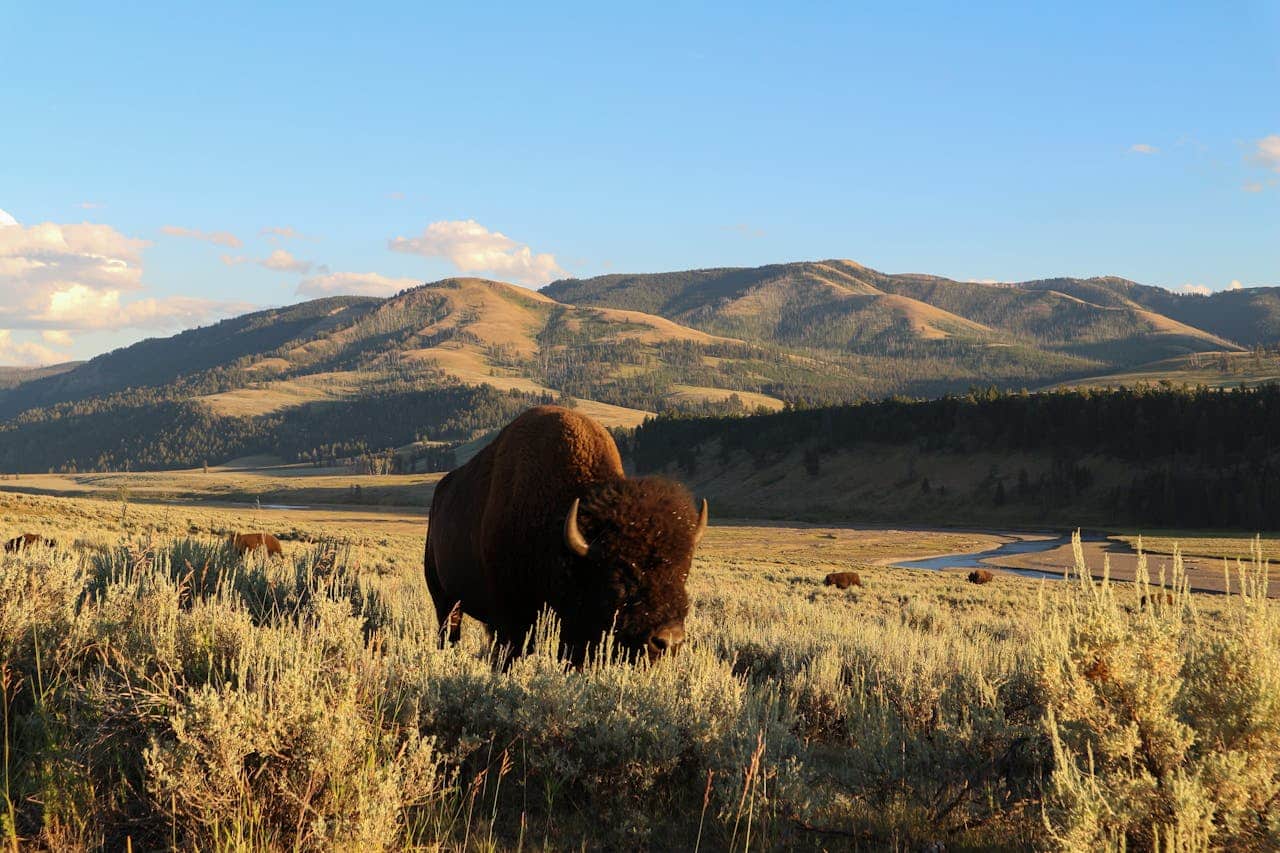
Let’s explore the majestic expanse of Yellowstone National Park, established in 1872. It is the first national park in the United States and attracts over 4 million visitors annually.
Spanning 2.2 million acres, this extraordinary park is home to geothermal wonders, wildlife encounters that feel like something out of a nature documentary, and a profound cultural heritage. Prepare to be mesmerized by Old Faithful, the stunning hues of the Grand Prismatic Spring, and the vast geological marvels that define this iconic destination. Discover why Yellowstone continues to capture hearts year after year!
Yellowstone’s rich narrative goes far beyond its geological features. For over 11,000 years, Indigenous communities have thrived in the Yellowstone region, harnessing its abundant resources through hunting and fishing. The pioneering Clovis culture skillfully crafted tools from local obsidian, showcasing their early ingenuity.
In 1877, a controversial interaction occurred between the Nez Perce tribe and tourists, leading to conflicts that marked a dramatic chapter in Yellowstone’s human history. Though Lewis and Clark didn’t directly explore the park, their expedition ignited curiosity that led adventurers like John Colter to brave its wilderness. The 1871 Hayden Geological Survey, led by notable figures such as William Henry Jackson and Thomas Moran, paved the way for Yellowstone’s recognition as a national park.
By the late 1800s, European-American exploration flooded into Yellowstone as people recognized its significance. In 1886, the U.S. Army took charge, maintaining order until the establishment of the National Park Service in 1916. Innovations like the Lacey Act of 1894 reflected the growing commitment to wildlife conservation, ensuring the park’s natural inhabitants remained protected.
Beyond natural conservation, Yellowstone actively safeguards its cultural legacy. The Heritage and Research Center plays a key role in preserving history through archival initiatives and educational programs. Collaborating with 27 Indigenous tribes, they honor and promote the rich cultural connections to this sacred land, exemplified in places like Fort Yellowstone, where stories from the past come alive.
Yellowstone reigns supreme in geothermal activities, boasting over 10,000 hydrothermal wonders that astound visitors. While Old Faithful is a standout, the vibrant hot springs, bustling with thermophiles, are equally captivating. Strict regulations, including Public Law 100-443, ensure that development is minimized, allowing the delicate balance between fire and water to flourish.
In 1988, significant wildfires swept through 36% of the park, prompting enhanced fire management strategies to safeguard the ecosystem.
Yellowstone serves as a home for an array of wildlife, featuring bears, wolves, and bison. The reintroduction of wolves in 1995 revitalized predator-prey dynamics, benefiting the overall biodiversity of the park. Observers noted healthier elk populations and improved riparian zones—nature truly found its balance once more. Additionally, thanks to the Clean Air Act, wildlife has thrived, demonstrating the synergy between conservation and legislation.
Climate change poses real challenges for Yellowstone, shifting wildlife behaviors and ecosystem dynamics. However, comprehensive acts like the National Environmental Policy Act enhance conservation initiatives, ensuring Yellowstone remains pristine for generations. The dismissal of harmful projects, such as the New World Mine, underscores the commitment to preserving this national treasure.
One summer, David and I took a trip to Yellowstone, where adventure awaited around every corner. We set out early, excited to see Old Faithful. We were surrounded by a crowd when it erupted, but it felt like the geyser was putting on a show just for us! Afterward, we hiked the trails, marveling at the bubbling hot springs and the vibrant colors of the Grand Prismatic Spring. Nature’s artwork amazed us. We spotted a family of bison grazing peacefully nearby, and shared a moment of quiet wonder. It reminded me that these experiences are what make life special, especially when shared with family.
Tourism in Yellowstone has a long history, starting with the first hotel at Mammoth in 1872. The arrival of automobiles in 1915 marked a pivotal moment, leading to an influx of visitors. By 1948, the park welcomed its millionth visitor, doubling that number by 1965 and reaching three million by 1992. Sites like the historic Roosevelt Lodge, established in 1920, continue to enchant visitors with their rustic charm.
Now, Yellowstone hosts over 4 million yearly visitors, with its infrastructure continually evolving to meet their needs. Initiatives such as Mission 66 enhance the visitor experience through ranger-led programs and informative visitor centers. The Grand Loop Road, designed in the late 1870s, remains crucial to the park’s tourism landscape.
Since 1917, the National Park Service has been the protector of Yellowstone’s natural wonders. Park rangers have diligently safeguarded the park since 1918, implementing key legislation like the Historic Sites Act of 1935 to maintain the integrity of its natural and historical features.
Controversy arises regarding wildlife management, particularly the wolf reintroduction efforts. Opinions vary on its impact on elk populations, while climate change continues to ignite debates about adaptation strategies. Infrastructure development raises questions about balancing necessity against preserving the park’s untouched wilderness. Furthermore, discussions about managing hydrothermal features spark ongoing debates about regulatory measures.
Yellowstone serves as a canvas for scientific research, attracting experts eager to explore its geothermal and ecological complexities. Research spans various topics, illuminating the connections between species and their habitats. Studies have shown how wolf populations contribute to the well-being of elk and other species, emphasizing the interconnectedness of life.
Strategic conservation initiatives in Yellowstone rely on data-driven approaches. Efforts to protect both geothermal formations and endangered species are supported by scientific evidence. Monitoring air quality due to the Clean Air Act Amendments demonstrates a commitment to analyzing and addressing environmental quality, ensuring that Yellowstone continues thriving for future generations.
Tourism significantly contributes to the economic landscape surrounding Yellowstone. Visitors generate millions in spending, fueling local businesses and driving growth in the community. Enhanced conservation programs also create job opportunities, fostering sustainable economic benefits while protecting the majestic environment.
Yellowstone offers a plethora of educational opportunities for visitors, from engaging ranger-led programs to interactive exhibits at visitor centers. These experiences foster a connection to nature and encourage stewardship of the environment. It’s not just about witnessing wonders; it’s about cultivating appreciation for this magnificent land.
The journey began with the construction of the original road system in the late 1870s, culminating with the Old Faithful Inn opening in 1904. The Union Pacific’s train service in 1908 further opened the floodgates of exploration.
Today, Yellowstone’s infrastructure undergoes continuous updates to align with conservation goals while supporting a growing visitor base. Balancing the need for safety and enjoyment with the preservation of natural habitats is critical to maintaining the integrity of the park.
Climate change presents ongoing challenges for Yellowstone, necessitating adaptive strategies to mitigate its effects. Research is essential for developing actionable plans to protect the park’s beauty and biodiversity. A holistic approach combining immediate responses with long-term strategies will be crucial.
The discourse surrounding wolf management remains a hot-button issue, reflecting different perspectives on its impact on the broader ecosystem. Additionally, discussions about hydrothermal feature regulations continue as stakeholders weigh the balance of use against conservation. Navigating these complexities calls for clear communication and shared objectives among all parties involved.
Are you ready to turn your Yellowstone adventures into reality? Start planning your incredible visit today! Utilize guides, maps, and resources to make the most of your journey through this breathtaking park. Don’t miss out on experiencing the wonders that beckon at every turn!
Q: What is the best time to visit Yellowstone National Park?
A: The optimal time of year depends on your interests. Summer attracts visitors for hiking and sightseeing, with everything fully accessible. Fall showcases stunning foliage and wildlife behavior, while winter transforms the park into a snow-laden wonderland suitable for snowshoeing and snowmobiling. Spring promises blooming flora and lively wildlife, though some roads may still be closed due to snow.
Q: How does visiting Yellowstone benefit local economies?
A: Your visit to Yellowstone greatly supports local businesses, from accommodations to dining establishments. Tourist spending injects millions into the economy each year, promoting growth and facilitating essential infrastructure developments while conservation efforts also create job opportunities.


The Montana Style is a participant in the Amazon Services LLC Associates Program, an affiliate advertising program designed to provide a means for sites to earn advertising fees by advertising and linking to Amazon.com
To learn more about Trevor Riggs, please visit our About page.
The Montana Style is a participant in the Amazon Services LLC Associates Program, an affiliate advertising program designed to provide a means for sites to earn advertising fees by advertising and linking to Amazon.com